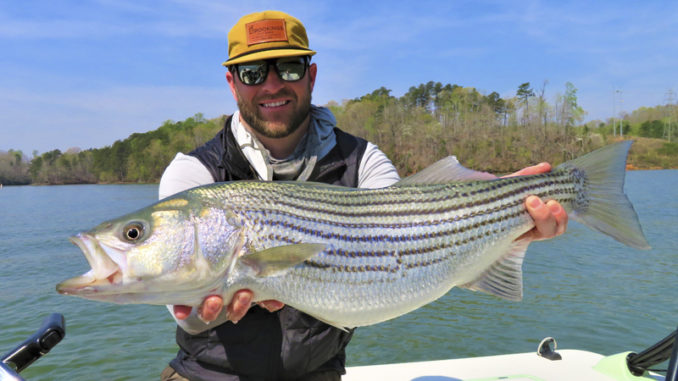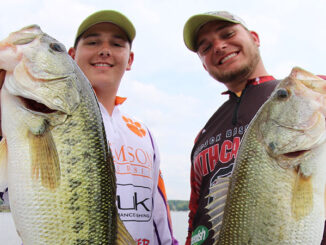
Fly fishing for stripers on moving water
In the spring a young man’s fancy turns toward love, but for lineside (hybrid/striper) fishermen, love turns toward the fish heading up the rivers to try and spawn.
For Capt. Harrison Beckwith of River Wizard Company, the question is which Lake Hartwell river will hold the fish that day. The five main rivers and creeks that the hybrids/stripers run on Lake Hartwell are: Coneross Creek, Martins Creek, Six and Twenty Creek, Keowee, and Tugaloo Rivers.
The spawn run for linesides generally starts in March or April depending on the water temperatures. They will start running up the rivers when the water temperatures hit in the high 50s.
When the water temperatures hits in the 70s around mid to late April, the run is usually over. Then fish will start heading back down the rivers toward Hartwell Dam. Because the water is so much cooler at the dam, they will hold down there during the hot summer.
When fishing in the rivers, Beckwith fishes like a bass fisherman and works visible structure. He will blind cast to the bank and let the line sink. Keeping the rod down until it almost touches the water, Beckwith will take the slack out of the line and then start what is called a “strip set.”
Stripers will often hit on the pause
A “strip set” consists of pulling the line tight and stripping the line in as soon as the fly hits the water. Strip, strip, pause and vary the pace. Beckwith will create action with the line, not the rod. And remember, tangles with the line are bound to happen.
The fish will usually hit on the pause, but this is not to say that they will not hit on the strip. When a fish hits, tighten the line, and set the hook.
Beckwith is constantly watching for schooling fish, and he says that you will have 3-4 seconds to hit them with the fly. When he sees the rings on the water, he will cast right past the rings in front of the fish.
“Cast to the rings and strip, strip, and pause,” he advises.
Beckwith mainly finds fish on his downscan sonar. After marking fish, he will throw out about 30-60 feet of sinking line and count down. So if fish are in 10 feet of water, the line will drop approximately 5-6 inches per second depending on the line. He will let it drop for 20 seconds, then start the “strip set.”
Choose reels with good drags, big line capacity
Beckwith keeps five different fly rods for different situations in the boat: floating, intermediate, and various sinking lines. He uses Hardy rods and reels. The rods are 9 feet long in 7- or 8- weight. The leader is 9 feet long of 15-pound test mono or fluorocarbon.
He uses Hardy saltwater grade reels because of the amount of line they hold and the good drag. These rods and reels are good for any type of freshwater or saltwater fishing.
The lures are # 2 through # 6 Clouser Minnow flies that Beckwith ties himself. They are made from saltwater grade Gamakatsu hooks and made with white and chartreuse bucktail.
Fishing times can vary according to weather conditions. Twenty-four to forty-eight hours before a storm is always the best time to fish. Usually from sunrise until 10 am will produce the best fishing. But stay until at least after lunch unless you are fishing all day.
In the afternoon, the best fishing will be between 4 pm and an hour before dark when most of the action will start. Schooling fish will usually start up before dark, but always fish until dark. Stripers are light sensitive.
Beckwith says, “It is a misnomer that you will catch smaller fish on a fly. You will catch the same quality as fishing artificial or live bait. Generally, you will not catch as many as live bait.”
“Catching fish on a fly is more work but more fun,” he said.
So if you are looking for some fun fly fishing for linesides, give Capt. Beckwith a call at 864-506-6920.




Be the first to comment